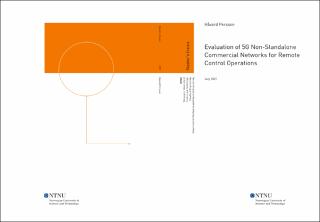| dc.contributor.advisor | Skavhaug, Amund | |
| dc.contributor.advisor | Petersen, Stig | |
| dc.contributor.advisor | Dittmann, Lars | |
| dc.contributor.author | Persson, Håvard | |
| dc.date.accessioned | 2021-10-07T17:21:20Z | |
| dc.date.available | 2021-10-07T17:21:20Z | |
| dc.date.issued | 2021 | |
| dc.identifier | no.ntnu:inspera:78072783:38500567 | |
| dc.identifier.uri | https://hdl.handle.net/11250/2788498 | |
| dc.description.abstract | Denne masteroppgaven undersøker mulighetene for fjernstyring av en robot mellom to universiteter, DTU i Danmark og NTNU i Norge, ved hjelp av det kommersielle 5G nettverket som er tilgjengelig på universitetene. Telekommunikasjonen er konfigurert til å kontrollere en AGV med en tilkoblet Raspberry Pi ved Manulab på NTNU. Oppgaven håndterer også en teoretisk oversikt over telekommunikasjonssystemet og og over et systematisert testverktøy.
Det ble besluttet å bruke tre Raspberry Pis (RPis) og en iPhone 12 som Endpoints for telekommunikasjonen. En Raspberry Pi koblet til AGVen (RPR), en på NTNU som fungerte som en hub (RPT), der robotsystemer skal kunne kobles til, og en p ̊a DTU (RPD). En iPhone 12 ble brukt som et alternativ for RPD. De tre Raspberry Piene implementerte 5G New Radio-teknologien ved å installere en 5G HAT.
De to RPiene på NTNU var koblet til et 3500 MHz 5G Non-Standalone kommersielt nettverk.
På samme måte koblet RPDen og iPhonen seg til et 700 MHz 5G Non-Standalone kommersielt nettverk. Denne oppgaven evaluerte systemets ytelse med kjerneevalueringer og seks nettverks testscenarier. RPT var den sentrale enheten i telekommunikasjonsoppsettet, noe som betydde at alle andre endepunkter ønsket å sende data til eller motta fra RPT.
For å gjøre målinger ble et verktøy for nettverksanalyse brukt, kalt Hawkeye. Dette verktøyet ble brukt til å måle KPIer mellom endepunktene i telekommunikasjonsnettverket. Hawkeye-testene simulerte scenarioer som var relevant for robotkontroll, og målte latency, pålitelighet og throughput under testen. Resultatene viste at kjernens ytelse til RPiene ikke forårsaket betydelig latency i hele systemet. Telekommunikasjonssystemet ble vurdert til å ikke være egnet for tidssensitive robotapplikasjoner, på grunn av høyere latency-verdier enn det som kreves av Industri 4.0-standardene. Den optimale løsningen av testscenariene ble vurdert til å være scenariet der kommunikasjonsforbindelsen mellom NTNU og DTU ble kablet. Dermed presenteres forslag til hvordan du kan forbedre systemet, og videre testing.
5G er under massiv utvikling, noe som betyr at dette telekommunikasjonssystemet vil bli videreutviklet når 5G-teknologien blir oppgradert der Raspberry Piene er. Systemoppsettet presenterer også et setup som kan konfigureres til et privat 5G Standalone nettverk, som gir operatørene bedre oversikt over bruken av båndbredde til robotsystemene.
Denne masteroppgaven utviklet et testoppsett for telekommunikasjon som er relevant for videre testing og evaluering. Et 5G privat Standalone nettverk kan sammenlignes med funnene i denne masteroppgaven. Testoppsettet, prosedyrene og metodikken kan brukes på nytt i dette private nettverket, for å isolere kvalitetene til Standalone 5G-nettverket. | |
| dc.description.abstract | This thesis investigates the possibilities for remote control operations between two universities, DTU in Denmark and NTNU in Norway, using the 5G commercial networks available at the universities. The telecommunication is configured to control an AGV with a connected Raspberry Pi at the Manulab facilities at NTNU. The thesis also addresses a theoretical overview of the telecommunication system and of a systematized testing tool.
It was decided to use three Raspberry Pis (RPis) and one iPhone 12 as endpoints for the telecommunication setup. One Raspberry Pi connected to the AGV (RPR), one at NTNU acting as a hub for communication (RPT), and one at DTU (RPD). The iPhone 12 was used as an option for the RPD. The three Raspberry Pis enabled 5G New Radio technology by installing 5G HATs.
The two RPis at NTNU were connected to a 3500 MHz 5G Non-Standalone commercial network. Similarly, the RPD and the iPhone were connected to a 700 MHz 5G Non-Standalone commercial network. This thesis evaluated the system’s performance with kernel evaluations and six network test scenarios. The RPT was the central unit of the telecommunication setup, meaning that all other endpoints wanted to send data to or receive from the RPT.
A networking analysis tool was used for measurements. This tool was used to measure KPIs between the endpoints of the telecommunication network. The Hawkeye tests simulated scenarios relevant for robotic control and measured latency, reliability, and throughput during these tests. Results showed that the kernel’s performance of the RPis did not cause a significant latency throughout the system. Furthermore, the telecommunication system was not suited for time-sensitive robotic applications due to higher latency than required for the Industry 4.0 standards. The test scenarios’ optimum solution was evaluated to be the scenario where the communication link between NTNU and DTU was wired, using the LAN of each university. Thus, suggestions of how to improve the system with 5G and further testing are presented.
5G is under massive development, meaning that this telecommunication system will be further developed when the 5G technology gets upgraded at the locations of the Raspberry Pis. The telecommunication test setup presents a setup that can be configured into a private 5G Standalone network, which provides the operators a better overview of the robotic systems’ bandwidth usage.
This thesis developed a telecommunication testing setup that is relevant for further testing and evaluation. Measurements of a 5G private Standalone network could be compared to the findings in this thesis. The test setup, procedures, and methodology can be reused in this private network, to isolate the qualities of the 5G standalone network. | |
| dc.language | eng | |
| dc.publisher | NTNU | |
| dc.title | Evaluation of 5G Non-Standalone Commercial Networks for Remote Control Operations | |
| dc.type | Master thesis | |
